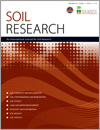SR16183Hydrogeological Landscapes framework: a biophysical approach to landscape characterisation and salinity hazard assessment
The Hydrogeological Landscape (HGL) framework provides a structure for understanding how salinity manifests in the landscape, how differences in salinity are expressed across the landscape and how salinity may best be managed. This is the first approach to specifically address all three manifestations of salinity: land salinity, in-stream salt load and in-stream salt concentration. The HGL framework is an expert system that integrates the spatial variability of landscape characteristics and salinity processes to produce a salinity hazard assessment for any given area.




